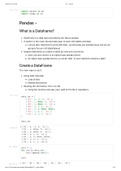Summary
Summary Python Data Operations 1: Data frames
- Course
- Institution
- Book
Notes of Pandas data operations covered in the Principles of Programming course, part of the Computer Science and AI bachelor degree. The notes are initially written in Jupyter Notebook. They contain practical examples of data operations in python and images to explain the structures and processes....
[Show more]



